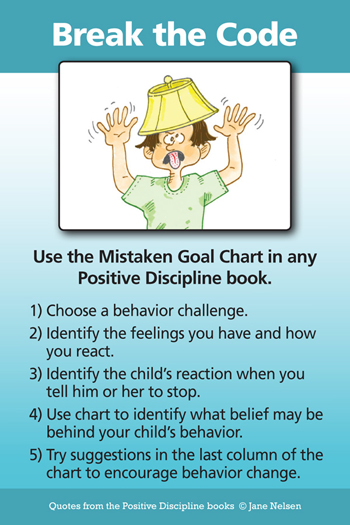When children are misbehaving, they are speaking to adults in code. A misbehaving child is a discouraged child. The primary goal of all children is to feel a sense of belonging and significance. Too often they form a mistaken belief about how to seek belonging and significance—as explained in the Mistaken Goal Chart. Unless adults know how to break the code—children usually experience the opposite of belonging and significance. Click on this link: Mistaken Goal Chart so you can follow along as I explain the code.
How you “feel” in response to the misbehavior provides the first clue to your child’s discouragement. You heard right. Your feelings help you break the code to your child’s mistaken belief about how to achieve belonging and significance—the true goal of all people. For example, when you feel irritated, annoyed, worried, or guilty, it is likely that your child’s mistaken goal is Undue Attention, based on the mistaken belief that, “I count (belong) only when I’m being noticed or getting special service. I’m important only when I’m keeping you busy with me.”
The second clue is your reaction to the misbehavior. Again, you heard right. The third column of the Mistaken Goal Chart summarizes adult behaviors that actually feed a child’s discouragement. Let’s take an example. Suppose your child is interrupting. You feel annoyed. You scold your child for interrupting. She stops for a few minutes (your third clue that the mistaken goal is Undue Attention per the fourth column of the Mistaken Goal Chart). By scolding, you have reinforced the discouragement. In a few minutes your child will try harder to get undue attention.
Once you have the three clues, you can break the code and understand what your child really needs to feel encouraged, “Notice Me. Involve Me Usefully.” Suggestions for what this kind of encouragement would look like are in the last column of the Mistaken Goal Chart. For example, one mother shared that her four-year-old constantly interrupted her the minute she got on the phone. This mom decided to encourage her daughter by choosing to “redirect by involving her child in a useful task to gain useful attention.”
The next time the phone rang, Mom told the caller to excuse her for a minute. She knelt down eye level to her daughter and took off her watch. Mom told her daughter to watch the second hand and let her know when it went around and past the 12 three times so she could end the phone call. Her daughter followed the second hand intently. Her mom hung up before the second hand went around three times and she said, “Mommy, mommy. You had more time.”
The daughter stopped interrupting and gained attention by contributing instead of annoying. This could be the beginning of changing her belief of something such as, “I belong when I am helping others,” instead of, “I belong only when others make me the center of the Universe.”
Change the Belief, Not Just The Behavior
Most parents don’t understand that there is a belief behind every behavior. Thus they make the mistake of trying to change just the behavior. The behavior will stop only when the belief behind the behavior is changed. Breaking the code helps you understand the discouraging belief behind the behavior and what the child really needs to feel encouraged enough to change his or her belief.
You have read an example of breaking the code for the mistaken goal of Undue Attention. The following activity will help you break the code for specific behaviors that are challenging to you so that you can be encouraging to your child and to yourself.
Break the Code Steps
- Describe a challenging behavior you are experiencing with your child.
- Identify your feelings. Remember that a feeling can be described with just one word. (Frustrated doesn’t count because it is a generic feeling that can be narrowed down to a more specific feeling. In the beginning you may need to look at the second column of the Mistaken Goal Chart to find the feelings that fit for you.) Write your feeling or feelings below.
- Describe what you usually do in response to the challenging behavior?
- Now get into your child’s world. How would you feel if you were a child and your parent did or said what you did or said?
- What would you be thinking?
- What would you be feeling?
- What would you decide to do? (This is a clue to the belief behind the action.)
- Look at the sixth column of the Mistaken Goal Chart to “break the code” and identify what the child needs.
- Choose a suggestion from the last column of the Mistaken Goal Chart that you would like to try the next time you encounter the challenging behavior. Describe how you think this might be encouraging to your child and how it might help your child revise his or her belief about how to find belonging and significance.
- Journal about the results of what you did. If it didn’t seem to work to change the behavior, is it possible that your child is at least making a new decision.
Use this worksheet until it becomes second nature and you will earn an honorary degree as a behavior detective and encouragement expert.



No Comments yet!